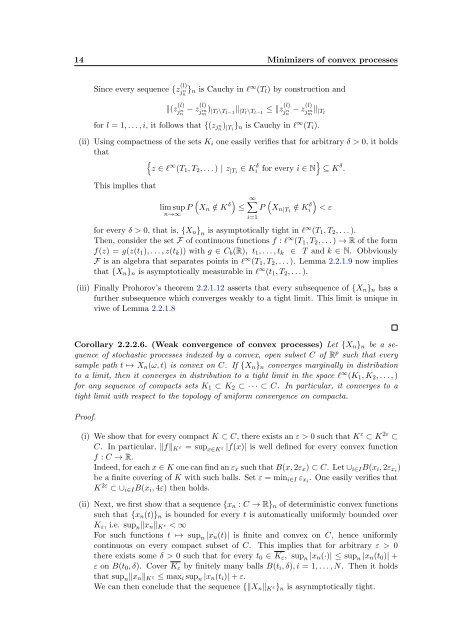Subsampling estimates of the Lasso distribution.
Subsampling estimates of the Lasso distribution.
Subsampling estimates of the Lasso distribution.
Create successful ePaper yourself
Turn your PDF publications into a flip-book with our unique Google optimized e-Paper software.
14 Minimizers <strong>of</strong> convex processes<br />
Since every sequence {z (l)<br />
j n n } n is Cauchy in l ∞ (T l ) by construction and<br />
‖(z (l)<br />
j n n<br />
− z(l) jm ) |T l \T l−1<br />
‖ |Tl \T l−1<br />
≤ ‖z (l)<br />
jn<br />
− z(l) jm ‖ |T l<br />
for l = 1, . . . , i, it follows that {(z j n n<br />
) |Ti } n is Cauchy in l ∞ (T i ).<br />
(ii) Using compactness <strong>of</strong> <strong>the</strong> sets K i one easily verifies that for arbitrary δ > 0, it holds<br />
that<br />
{<br />
}<br />
z ∈ l ∞ (T 1 , T 2 , . . . ) | z |Ti ∈ Ki<br />
δ for every i ∈ N ⊆ K δ .<br />
This implies that<br />
(<br />
lim sup P X n /∈ K δ) ≤<br />
n→∞<br />
∞∑<br />
P<br />
i=1<br />
(<br />
X n|Ti<br />
)<br />
/∈ Ki<br />
δ < ε<br />
for every δ > 0, that is, {X n } n<br />
is asymptotically tight in l ∞ (T 1 , T 2 , . . . ).<br />
Then, consider <strong>the</strong> set F <strong>of</strong> continuous functions f : l ∞ (T 1 , T 2 , . . . ) → R <strong>of</strong> <strong>the</strong> form<br />
f(z) = g(z(t 1 ), . . . , z(t k )) with g ∈ C b (R), t 1 , . . . , t k ∈ T and k ∈ N. Obbviously<br />
F is an algebra that separates points in l ∞ (T 1 , T 2 , . . . ). Lemma 2.2.1.9 now implies<br />
that {X n } n is asymptotically measurable in l ∞ (t 1 , T 2 , . . . ).<br />
(iii) Finally Prohorov’s <strong>the</strong>orem 2.2.1.12 asserts that every subsequence <strong>of</strong> {X n } n has a<br />
fur<strong>the</strong>r subsequence which converges weakly to a tight limit. This limit is unique in<br />
viwe <strong>of</strong> Lemma 2.2.1.8<br />
Corollary 2.2.2.6. (Weak convergence <strong>of</strong> convex processes) Let {X n } n be a sequence<br />
<strong>of</strong> stochastic processes indexed by a convex, open subset C <strong>of</strong> R p such that every<br />
sample path t ↦→ X n (ω, t) is convex on C. If {X n } n converges marginally in <strong>distribution</strong><br />
to a limit, <strong>the</strong>n it converges in <strong>distribution</strong> to a tight limit in <strong>the</strong> space l ∞ (K 1 , K 2 , . . . , )<br />
for any sequence <strong>of</strong> compacts sets K 1 ⊂ K 2 ⊂ · · · ⊂ C. In particular, it converges to a<br />
tight limit with respect to <strong>the</strong> topology <strong>of</strong> uniform convergence on compacta.<br />
Pro<strong>of</strong>.<br />
(i) We show that for every compact K ⊂ C, <strong>the</strong>re exists an ε > 0 such that K ε ⊂ K 2ε ⊂<br />
C. In particular, ‖f‖ K ε = sup x∈K ε |f(x)| is well defined for every convex function<br />
f : C → R.<br />
Indeed, for each x ∈ K one can find an ε x such that B(x, 2ε x ) ⊂ C. Let ∪ i∈I B(x i , 2ε xi )<br />
be a finite covering <strong>of</strong> K with such balls. Set ε = min i∈I ε xi . One easily verifies that<br />
K 2ε ⊂ ∪ i∈I B(x i , 4ε) <strong>the</strong>n holds.<br />
(ii) Next, we first show that a sequence {x n : C → R} n <strong>of</strong> deterministic convex functions<br />
such that {x n (t)} n is bounded for every t is automatically uniformly bounded over<br />
K ε , i.e. sup n ‖x n ‖ K ε < ∞<br />
For such functions t ↦→ sup n |x n (t)| is finite and convex on C, hence uniformly<br />
continuous on every compact subset <strong>of</strong> C. This implies that for arbitrary ε > 0<br />
<strong>the</strong>re exists some δ > 0 such that for every t 0 ∈ K ε , sup n |x n (·)| ≤ sup n |x n (t 0 )| +<br />
ε on B(t 0 , δ). Cover K ε by finitely many balls B(t i , δ), i = 1, . . . , N. Then it holds<br />
that sup n ‖x n ‖ K ε ≤ max i sup n |x n (t i )| + ε.<br />
We can <strong>the</strong>n conclude that <strong>the</strong> sequence {‖X n ‖ K ε} n is asynmptotically tight.
















